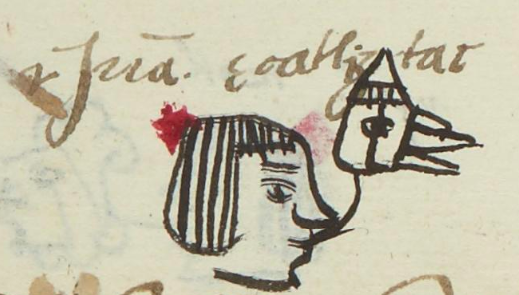Ecatl Iztac (MH575r)
This black-line drawing of the compound glyph for the personal name Ecatl Iztac (“Air-White,” attested here as a man’s name) shows a duck-like head with an open eye and an open beak, a small protrusion above the beak, a white (iztac) face, and a white conical cap. The face has a black horizontal line, possibly face paint or a tattoo. The base of the hat has hash marks.
Stephanie Wood
The gloss gives "Ecatl," but the visuals suggest "Ehecatl." A great many glyphs in this collection start with Eca- when one might expect Eheca-. We are preserving the proclivity of the gloss for Eca-, while also pointing to the likelihood of an unintentional oral abbreviation of Eheca- to Eca-.
The duck head recalls the mask of Ehecatl (the spirit or divine force of wind), with the diagnostic vertical line on his cheek and the conical hat (copilli). The conical hat is linked with the Huasteca and was worn by both Ehecatl and Quetzalcoatl. [See: Peter O. Koch, The Aztecs, the Conquistadors, and the Making of Mexican Culture (2015, 8).] It is not unusual for a an ehecatl (wind) glyph to be glossed ecatl (air, breath), as it is here.
Stephanie Wood
juā ecatliz tac
Juan Ecatl Iztac
Stephanie Wood
1560
Jeff Haskett-Wood
aires, vientos, aliento, deidades, espíritos, divinidades, fuerzas naturales

Ehecatl or eheca(tl), wind, or the spirit or divine force of the wind, https://nahuatl.wired-humanities.org/content/ehecatl
eca(tl), air or breath, https://nahuatl.wired-humanities.org/content/ecatl
iztac, white, https://nahuatl.wired-humanities.org/content/iztac
El Aire Blanco, o El Viento Blanco
Stephanie Wood
Matrícula de Huexotzinco, folio 575r, https://www.loc.gov/resource/gdcwdl.wdl_15282/?sp=229&st=image
This manuscript is hosted by the Library of Congress and the World Digital Library; used here with the Creative Commons, “Attribution-NonCommercial-ShareAlike 3.0 License” (CC-BY-NC-SAq 3.0).




